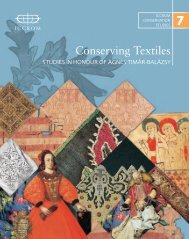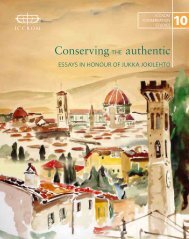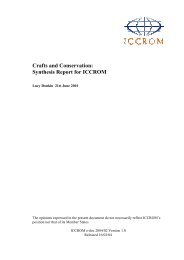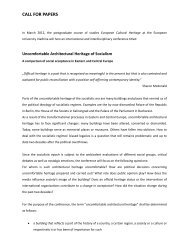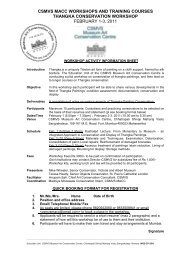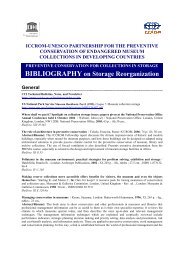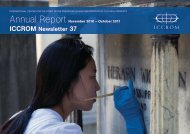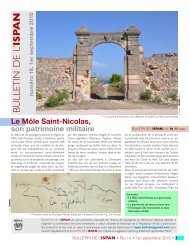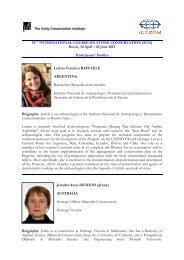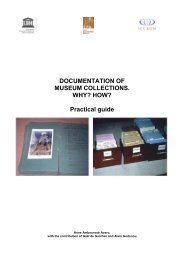part 1 - Iccrom
part 1 - Iccrom
part 1 - Iccrom
Create successful ePaper yourself
Turn your PDF publications into a flip-book with our unique Google optimized e-Paper software.
MEASURING HERITAGE CONSERVATION PERFORMANCE<br />
6th International Seminar on Urban Conservation<br />
1.6. The construction of the<br />
site: content and form<br />
The creation of the website followed a logic of construction<br />
based on historical interpretation, morphological<br />
interpretation, and the interpretation of the<br />
traditional popular manifestations of the site, held<br />
in interaction with the local community. The methodology<br />
adopted involved the local community in<br />
the decisions to be taken, ranging from the design<br />
of material containing information to the formatting<br />
of the final product. To do this, the CECI technical<br />
team endeavoured to raise awareness among<br />
the various social actors present (religious bodies,<br />
residents, owners of bars and restaurants, city managers)<br />
of the relevance of the historical and artistic<br />
value attributed to the site by calling attention to its<br />
cultural significance and the importance of the role<br />
of the community as a ‘guardian of heritage’.<br />
The stages of the work consisted of: identifying the<br />
place, defining the themes, analysing the relationship<br />
of the community with the history of the site<br />
and the construction of the narrative; these sometimes<br />
took place simultaneously.<br />
1.7. The historical interpretation<br />
Saint Peter of the Clerics Courtyard is considered<br />
one of the most expressive architectural and urban<br />
groupings of Baroque culture in Pernambuco, in<br />
which the importance of the Church of Saint Peter<br />
of the Clerics stands out. The church, with its traces<br />
of Baroque, and the houses surrounding it have<br />
been the subject of numerous studies in the field of<br />
the history of art and architecture. These have given<br />
high value to this religious monument and the<br />
architectural grouping, and have categorized it as<br />
a national historical and artistic heritage asset. Saint<br />
Peter of the Clerics Courtyard keeps, in its urban<br />
configuration, traces of Dutch Baroque, which had a<br />
profound impact on the history of Recife. Archaeological<br />
studies carried out in the late 1990s showed<br />
that an aspect of the layout of the group of houses of<br />
the courtyard was <strong>part</strong> of the so-called City Maurícia<br />
or ‘Mauritiopolis’, designed and constructed during<br />
the government of Maurice of Nassau (1637-1644).<br />
1.8. The morphological interpretation<br />
The urban and architectural grouping of the Saint<br />
Peter of the Clerics Courtyard consists of the Church<br />
of Saint Peter, the courtyard and 63 buildings that<br />
surround the four sides of the church. The buildings<br />
surrounding the church are mostly single-story<br />
houses, but include three two-storey town houses<br />
(sobrados) and twelve one-story town houses. The<br />
greatest incidence of townhouses in the courtyard is<br />
in the block opposite the church façade, thus creating<br />
a dialogue between the voluminous buildings<br />
in the tall category. The townhouses, in general,<br />
stand out because of their height, which is different<br />
from the rest, and the fine decorative work on<br />
their façades; these are the most ornate, with friezes,<br />
entablatures, balconies and a large number of spans.<br />
The ground-level houses are traditional two-door<br />
vernacular buildings, twinned on either side, with<br />
mortar façades, except for a few buildings that are<br />
covered in ceramic and brick tiles. The doors and<br />
windows of the ground-level houses have straight<br />
or shallow arched lintels, one feature being stone or<br />
mortar frames. Most of the roofs are covered with<br />
ceramic channel tiles, of the gutter and spout type,<br />
and their ridges are parallel to the street, i.e. parallel<br />
to the sides of the church. Almost all roofs are<br />
<strong>part</strong>ially hidden by the parapets that rise from the<br />
façades and create gutters for rainwater runoff.<br />
The urban design and the built grouping still<br />
maintain a good level of completeness, which make<br />
it a site of great value as it recalls the past so well,<br />
though its uses have been greatly modified since the<br />
late 1960s.<br />
1.9. The interpretation of popular<br />
and artistic manifestations today<br />
Saint Peter of the Clerics Courtyard has been the<br />
stage for various traditional popular manifestations.<br />
In order to make an interpretation of the current<br />
culture regarding the courtyard, knowledge needs<br />
to be gained of the main cultural events that take<br />
place on the site. This includes shows that present<br />
traditional and popular songs and dances, whether<br />
sacred or profane; displays of art and a wide range<br />
of gastronomical options; institutions that do their<br />
business; and the character and types of services<br />
offered. Research on these cultural expressions was<br />
conducted in various registries in the city, and a<br />
large number of hard copy references and items of<br />
iconography were found.<br />
In the Saint Peter Courtyard there are three institutions<br />
of relevance to culture: the Casa do Carnaval,<br />
the Aloizío Magalhães Museum of Modern Art and<br />
the Training Centre for Visual Arts. The first works<br />
with popular culture and the others with the contemporary<br />
development of the visual arts by organizing<br />
exhibitions and performances.<br />
The documentary searches carried out to interpret<br />
current culture were supplemented by statements<br />
Ribeiro, C.; Lira, F.; Piccolo, R. & V. Pontual. 2012. Conserving and identifying heritage: A methodological contribution. In Zancheti,<br />
S. M. & K. Similä, eds. Measuring heritage conservation performance, pp. 15-25. Rome, ICCROM.<br />
18



